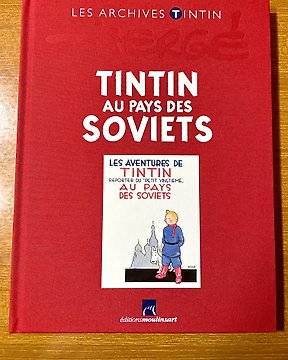
Tintin T1 - Tintin au pays des Soviets - Les Archives Tintin - C - Eerste druk - (2012)
Nr. 14648617

Nr. 14648617

Magnificent album, from the very first print run of 500 copies.
This album is embellished with a dedication signed by Hergé on November 9, 1939, which makes it a unique and historical document:
"To Mr. Ernest Closson, hoping that he will highly appreciate the courage displayed by Tintin to avoid a fratricidal war between Syldaves and Bordures, with respectful and friendly greetings, Hergé, 9.11.39".
We are witnesses of Hergé's thoughts at a pivotal time of his life: by the end of 1939, World War II is approaching and he is mobilised ... Due to these circumstances, the first edition of Le Sceptre d'Ottokar would be exceptionally printed without the typical full-page colour drawings.
Could Tintin have prevented the Second World War?
It was in any case the deepest wish of Hergé!
Hergé said of himself: "Tintin, it was me, with all that there is in me of need for heroism of courage, of righteousness ... and the subjects I chose were subjects that mattered to me, I felt I had to say something about. "
This is why Hergé's made Tintin resist the Japanese invasion of China in Le Lotus Bleu in 1934/1935 and prevent the annexation of Syldavia by Borduria in Le Scepter d Ottokar in 1938/1939.
Hergé of course alluded to the annexation of Austrian, Czechoslovak and Albanian territory by the German and Italian fascist regimes at the time. The name of Müsstler, the leader of the pro-Bordurian Steel Guard Movement which seeks to invade Syldavia, is in fact the combination of the names of Mussolini and Hitler. For the title layout of the album that appeared in late 1939, Hergé had even asked his publisher to use Gothic letters! This was refused by Casterman, because ... "it would be hard to read for kids".
Why was the first edition of Le Sceptre d'Ottokar printed at only 500 copies?
In preparation for the publication of the album at the end of 1939, the following correspondence develops by letter between Charles Lesne (editorial director of Casterman) and Hergé:
September 6
Germaine Remi sends the cover drawing of the album to Charles Lesne and apologizes for the delay, caused by the fact that Hergé has been mobilized [since September 1]
September 14
In reply, Charles Lesne worries about Hergé's delay in preparing the full-page colour drawings and asks to send them as soon as possible.
October 19
Hergé, who has now been demobilized for a month, has finished the colour drawings and delivered them to Casterman. Unfortunately, the editor will not be able to complete the photo-etching and printing process in time. Charles Lesne asks Hergé for advice: is it better to release a part of the album without the full-page colour drawings in early November, or should he wait for the drawings and release the album at the beginning of December?
October 23
Hergé agrees to release a part of the print run of the album asap without the colour drawings, "so that the department stores can display it in their St. Nicholas shop windows right from the start". Otherwise, he says, "If we wait until the end of November, we will miss part of the sale."
November 3
Charles Lesne confirms: "We've decided to put 500 albums in production without colour drawings that will be available next Thursday and will be used 1 °) for the most urgent shipments to bookstores - 2 °) for the press release. You (Hergé) could therefore come Thursday to sign and dedicate the albums for the press".
This "next Thursday" being November 9, 1939, this copy of Le Sceptre d'Ottokar will be dedicated by Hergé on the very day of the official presentation of the album to the press in the following way:
"To Mr. Ernest Closson, hoping that he will highly appreciate the courage displayed by Tintin to avoid a fratricidal war between Syldaves and Bordures, with respectful and friendly greetings, Hergé, 9.11.39".
Léonard Mathieu "Ernest" Closson (1870-1950) was the curator of the Museum of Musical Instruments (Old England) in Brussels until 1936. He was also a publicist, among others for Le Flambeau, Belgian Liberal magazine on political and literary questions and for the liberal newspaper L'Indépendance Belge. It was probably as a representative of one of these publications that he met Hergé during the press release of the album on November 9th. It is clear that the two men, facing the imminence of the Second World War, commented on the adventures of Tintin in Syldavia,...
Hergé thus confirms his motivation in writing Le Sceptre d'Ottokar and at the same time expresses his wish that Tintin could have avoided the Second World War ...
Being dated exactly on November 9, 1939, this album is indisputably one of the rare authentic copies of the first print run of only 500 copies. Unfortunately, copies of the second edition are often presented with the colour drawings cut out, trying to pass them as first editions ...
Condition of the album:
The album has hardly been read, covers, back and spine are magnificent.
The corners are well pointed, the caps are not bumped.
The pages are all fixed and in remarkable condition, no traces of reading, no tearing or writing.
The album has not been restored.
The purchaser of this unique album will also receive photocopies of the above quoted correspondence between Hergé, Germaine and Casterman (5 letters).
Also up for auction now is the 1939 folder that Casterman printed for St Nicholas, Christmas and New year and that announces the newest album: Le Sceptre d'Ottokar.
The album can be picked up (free of charge).
Personal delivery possible in France and Belgium (subject to payment of charges, calculated according to distance).
Zo koop je op Catawiki
1. Ontdek iets bijzonders
2. Plaats het hoogste bod
3. Veilig betalen